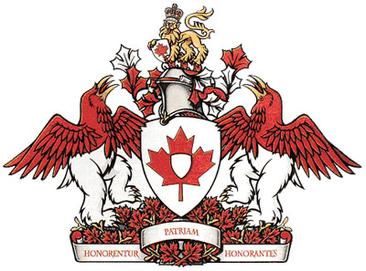Canadian Heraldic Authority
The authority is responsible for the creation and granting of new coats of arms (armorial bearings), flags, and badges for Canadian citizens, government agencies, municipal, civic and other corporate bodies.
Now know Ye that We, by and with the advice of our Privy Council of Canada, do by these presents authorize and empower Our Governor General of Canada to exercise or provide for the exercise of all power and authorities lawfully belonging to Us as Queen of Canada in respect of the granting of armorial bearings in Canada.Prior to the creation of the Canadian Heraldic Authority, Canadians wishing to obtain a legally granted coat of arms had to apply to one of the two heraldic offices in the United Kingdom: either the College of Arms in London or the Court of the Lord Lyon in Edinburgh.
In addition, the heralds of the College of Arms and the Court of the Lord Lyon could sometimes be unfamiliar with Canadian history and symbols.
[4] As early as 1967, plans were reportedly in the works to transfer overview of heraldry from the College of Arms in the UK to Canada.
[4] In 1986, Vicki Huntington, a politician from British Columbia, forwarded a brief written by the RHSC calling for the creation of the Canadian Heraldic Authority to a staff member in then-Secretary of State David Crombie's office.
[4] Mr. Crombie had his department organise a meeting in Ottawa the following year, to which many national and international heraldic experts were invited.
"[4] Two years later, Queen Elizabeth II issued the 1988 letters patent authorising the governor general "to exercise or provide for the exercise of all powers and authorities lawfully belonging to Us as Queen of Canada in respect of the granting of armorial bearings in Canada".
Subsequently, the Governor General, Jeanne Sauvé, authorised the creation of the Canadian Heraldic Authority on June 4, 1988.
[21] In order to request either a coat of arms, flag, and/or badges, a letter must be addressed to the Chief Herald of Canada.
Under Canadian bilingualism laws, letters patent are written in both English and French, though the petitioner may choose which language will be placed in the left column of the document.
[23] The average time needed to complete a grant is about 12 to 14 months, though it can take longer for particularly detailed or intricate arms.
[20] From July 20, 2021, the Canadian Heraldic Authority announced on its Facebook page the launch of online grant application forms, in an effort to modernize the institution and make the "900-year-old tradition" available to all those who are eligible.
The blazon, or technical description in heraldic language, of the full armorial bearings is below, along with its plain English description: The current arms of the authority were confirmed in a warrant by the Governor General on 15 January 1994, in honour of the authority's fifth anniversary, which was celebrated the previous year.
[26] The shield and crest alone comprise the heraldic badge of the CHA, which is used on the seal of the Authority and on the letters patent that grant and register armorial bearings.

